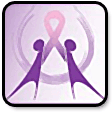Epidemiology Branch

The NIEHS Sister Study (Spanish) is a prospective cohort study of environmental and genetic risk factors for breast cancer and other diseases among 50,884 sisters of women who have had breast cancer. Such sisters have about twice the risk of developing breast cancer as other women, with about 300 new cases of breast cancer expected to be diagnosed each year. Having a risk-enriched cohort improves statistical power to identify potential modifiable risk factors and for assessing the interplay of genes and environment. Additionally, sisters are often highly motivated to participate in long-term breast cancer research because their family member has experienced the disease. Thus, the response rates and compliance have been high. The prospective design allows the assessment of exposures before the onset of disease, thereby avoiding biases common to retrospective studies.
Study enrollment opened nationally in October 2004 (after a run-in period in selected cities that began in July 2003) and closed in July 2009. Eligible women were 35 to 74 years of age, lived in the United States, including Puerto Rico, and had a sister diagnosed with breast cancer but did not have breast cancer themselves. Multiple recruitment strategies were used to enroll a diverse cohort of women with a variety of different life experiences and exposures.
Baseline data on potential risk factors and current health status were collected in telephone interviews and mailed questionnaires. Blood, urine, and environmental samples were collected during a baseline home visit and banked for future use in nested case-cohort or case-control studies of breast cancer or other diseases. Stored samples include whole blood, cryopreserved whole blood or lymphocytes (12% random sample), plasma, serum, urine, toenail clippings, and household dust collected with alcohol wipes. A small subset of participants provided a second set of biological and environmental samples 4-10 years after the first. The cohort is being followed prospectively, with contact information and major changes to health updated annually. Comprehensive triennial questionnaires update medical history and changes in exposures, with opportunities for special surveys (e.g., questionnaires for breast cancer survivors or a COVID-19 questionnaire).
Sister Study research occurs within the cohort and through consortia efforts that pool data from multiple cohorts. Breast cancer has been the major focus, but a wide range of other conditions have also been studied. Medical records, pathology reports, and tumor tissue blocks are sought for women who develop breast or ovarian cancer. For other cancers, pathology reports are requested. Other self-reported health outcomes are validated for special studies.
Principal Investigator
-
Dale P. Sandler, Ph.D.
Chief, Epidemiology Branch and Senior Investigator -
Tel 984-287-3711
Fax 301-480-3290
[email protected]
Co-investigators
-

-
Clarice R. Weinberg, Ph.D.
Principal Investigator -
Tel 984-287-3697
[email protected] -
P.O. Box 12233Mail Drop A3-03Durham, NC 27709
-

-
Jack A. Taylor, M.D., Ph.D. (Retired)
Scientist Emeritus -
Tel 984-287-3684
[email protected]
-

-
Alexandra J. White, Ph.D., M.S.P.H.
Stadtman Investigator -
Tel 984-287-3713
[email protected] -
P.O. Box 12233Mail Drop A3-05Durham, NC 27709
-

-
Chandra L. Jackson, Ph.D., M.S.
Stadtman Investigator -
Tel 984-287-3701
[email protected] -
P.O. Box 12233Mail Drop A3-05Durham, NC 27709
-

-
Katie M. O'Brien, Ph.D.
Staff Scientist -
Tel 984-365-9283
[email protected] -
9609 MEDICAL CENTER DR.9609 MEDICAL CENTER DRIVERockville, MD 20892


